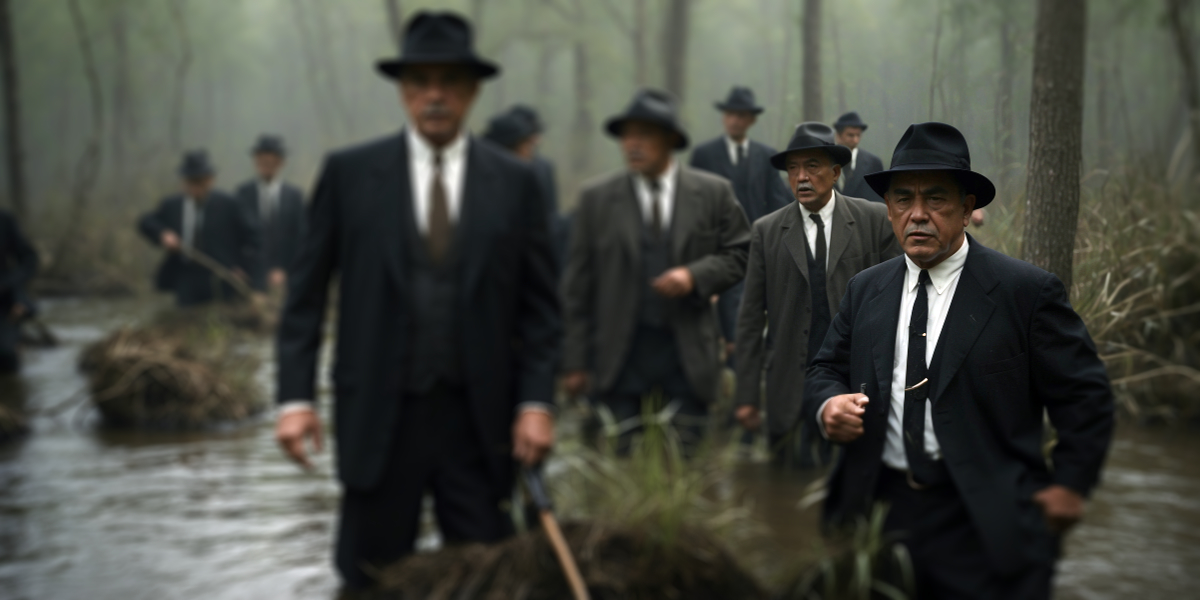‘Dead’ man returns to Louisiana alive
Sam Jones, 38, told New Orleans States reporter George Jackson he didn’t know until the fall of 1951 that he had been “murdered” in 1949. The lanky six-footer spoke with Jackson that year inside the Denver police station, where police arrested him in the climax of a grotesque case. Back home in Louisiana, Donald Easterwood, a World War II veteran, had confessed to killing Sam Jones and stood trial for his murder.
A body found in a Gretna Swamp was identified as Jones by his common-law wife, Patricia Land, 41, who swore at the trial that she watched Donald Easterwood and another man, Ernest Howard, stab Jones through the heart the night he disappeared. She identified the decaying corpse by the clothing on the body and by his “crooked pinky finger.”
However, Jones described his last night in Louisiana differently. Regarding the night of March 11, 1949, he said, “Pat and I weren’t getting along. She fussed at me, and I fussed back. I got disgusted and worried.”
“That night—I think it was about 11 o’clock—I decided to take off. I took 80 dollars from the filling station where I worked, and when a cab came by, I rode down to the bus station. It wasn’t more than a few minutes until the bus left.”
“I got to Dallas the next day, stayed there for two or three days, and then went to Oklahoma City. I stayed there for about a week and then came out here.”
“I never had been out here before. I had an uncle in Colorado Springs and intended to see him but never found him.”
Although Jones has been in Denver for two years, he told reporters he had not located his uncle yet.
Jones, who used the name John Harper in Colorado, said he had worked in restaurants and on farms since his arrival in Denver. “Really, I took any kind of labor job I could find,” he said.
Jones said he didn’t learn of his supposed death until the previous fall. He said John Painter told him about the case.
In July 1951, The New Orleans States gave Jefferson parish authorities information—supplied by a tipster—that allowed police to confirm that Sam Jones was alive.
John C. Painter, a 35-year-old itinerant farm worker, phoned the newspaper early one morning from Tangipahoa Parish, where he worked, and said he had seen Jones in Denver. States Reporter Robert Webb interviewed Painter that day and set the wheels in motion.
Later that morning, George Jackson got involved and asked Painter to tell his story to authorities in Jefferson Parish.
Painter agreed, and Jackson drove him to see John Faulkner, a deputy sheriff in Jefferson Parish. Painter convinced Faulkner that he had seen Jones, prompting Faulkner to notify his boss, Sheriff Frank J. Clancy, who contacted police in Denver.
On Tuesday, July 24, 1951, Jackson flew to Denver, bringing Painter along. Cy Diliberto, another Jefferson Parish deputy sheriff, also made the trip.
The following day, Painter located Sam Jones.
“I was here walking around,” Jones told Jackson, “When I saw Painter walking down the street, I hollered at him. He asked me where I came from and told me he thought I was dead.”
“It was the first time I’d heard that, so I found it kinda funny at first. I said, Hell man, I’m still walking around.”
Jones told his interviewers he had not spoken to anyone in Louisiana since leaving New Orleans. “I didn’t know anybody to write down there, and I didn’t know if the sheriff’s office was after me for that 80 bucks.”
He said he knew nothing about the Easterwood trial or that authorities had charged someone with his murder. He told Jackson he had no idea why Easterwood confessed to a murder that never happened.
F. Irvin Dymond, the New Orleans defense attorney who won acquittal for Donald Easterwood at his trial, told reporters, “The sheriff’s office was looking for Jones regarding the money missing from the filling station at 1500 St. Charles Avenue. They found that Easterwood, another station employee with no alibi for that night, had just bought a car. They suspected him of taking the money and spent hours grilling him. In time, Easterwood signed a written confession, saying he had killed Sam Jones when Jones caught him stealing the loot from the cash register.”
When Judge Frank T. Echezebal read the confession and found Donald Easterwood attributed the injuries on his face to Beauregard Miller, the Gretna town marshal who extracted the confession, Judge Echezebal threw out the document and dismissed the case.
John C. Harper, alias Sam Jones, stood trial for stealing the 80 dollars. Found guilty, he served four months in the Jefferson Parish jail.
Patricia Land, who fled to Missouri after Eaterwood’s acquittal, never explained why she lied about witnessing Sam Jones’ murder. At her perjury trial in 1952, Judge William J. O’Hara sentenced Patricia Land to “18 months of hard labor.”
During her trial, prosecutors suggested Patricia Land lied to conceal the true identity of the body pulled from the Gretna swamp.
The New Orleans Item newspaper suggested the man resembled Larry Schoenbeger, the missing newsman who filed charges against two men for breaking his camera on the courthouse steps in January 1948. The court found “no true bill” and dismissed the property damage case when Schoenbeger did not appear.
However, both defendants did attend court. One was an ex-prizefighter named Salvatore Marciante. Court documents described the other defendant as “a Grand Isle fisherman” named Carlos Marcello.

